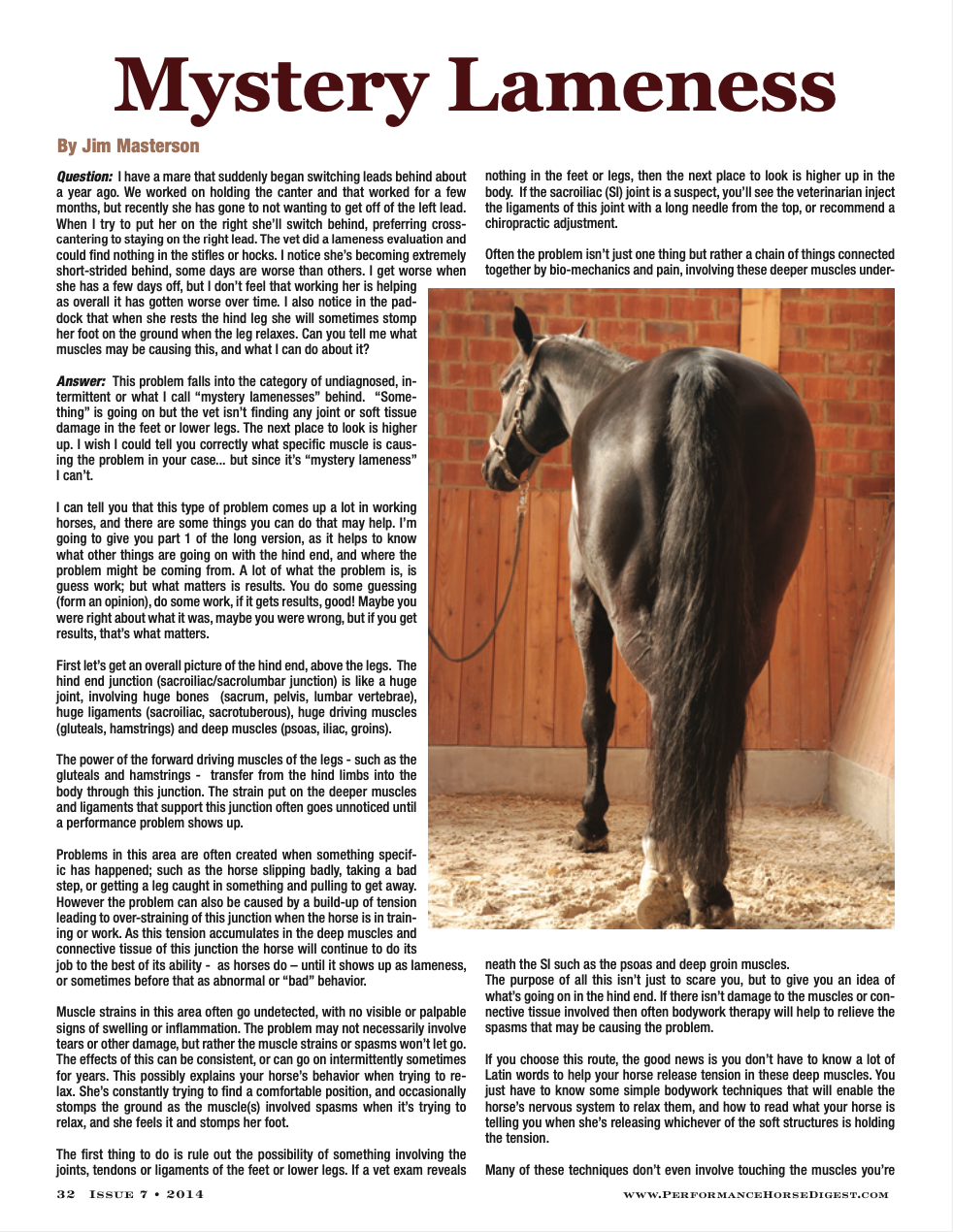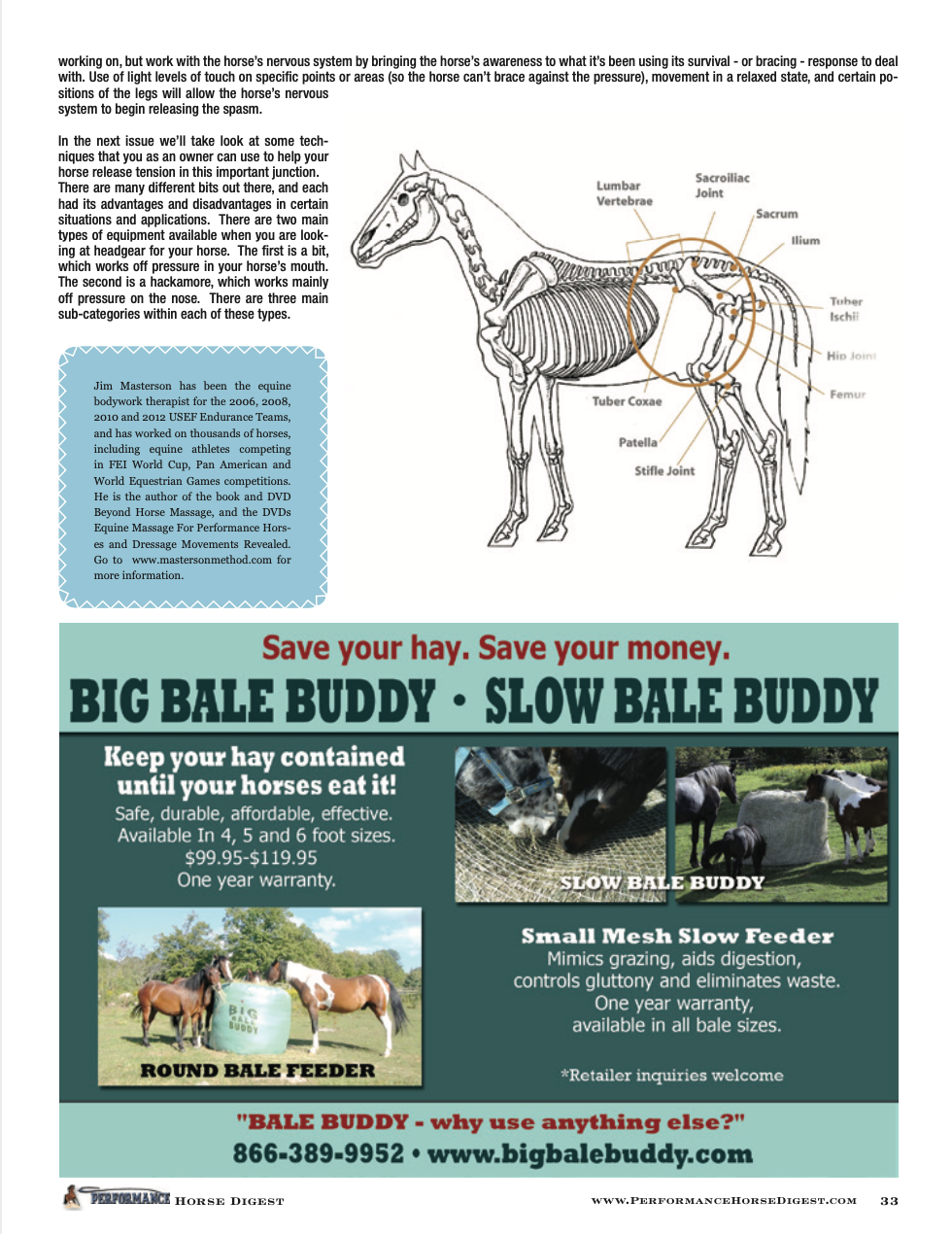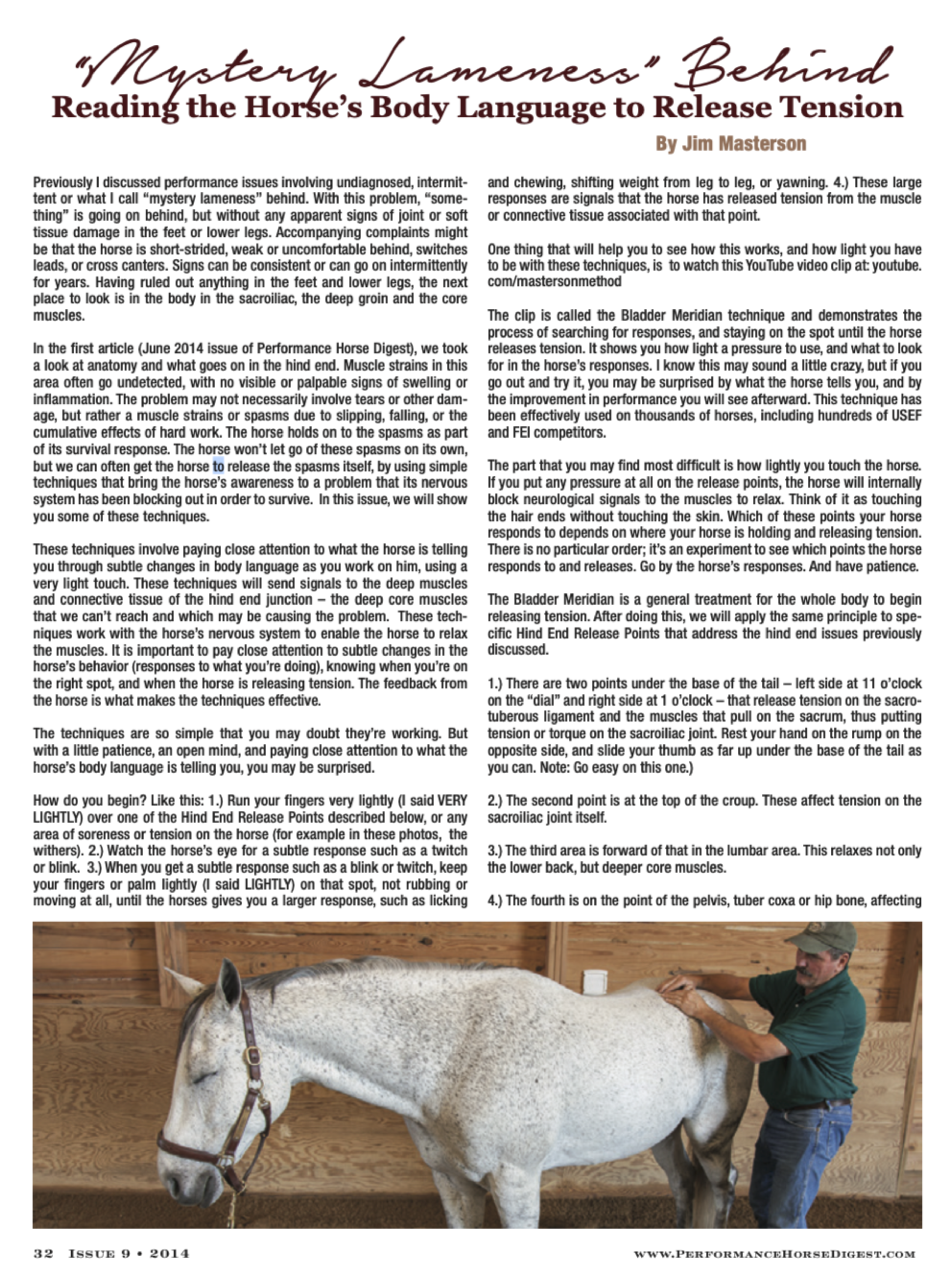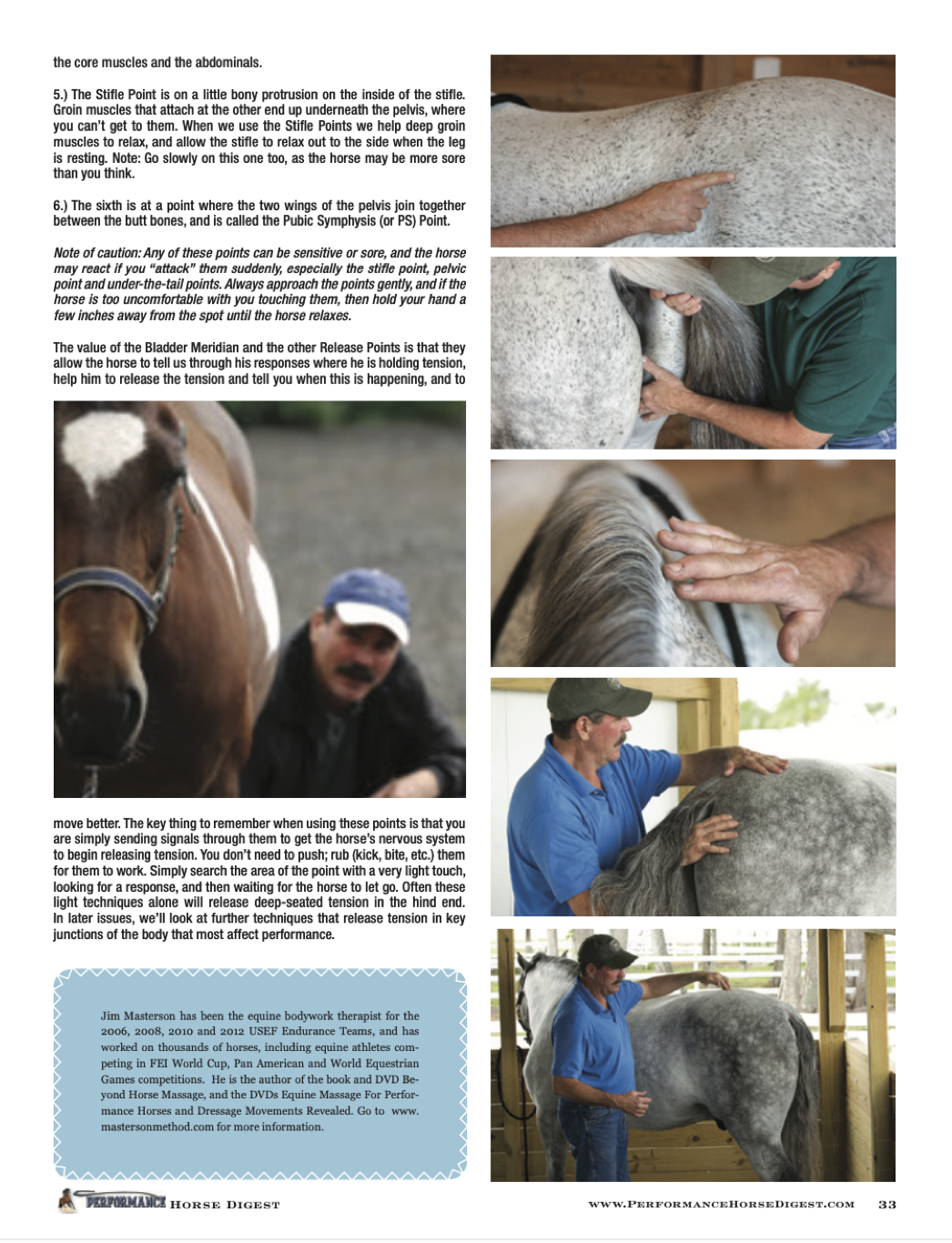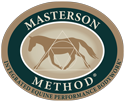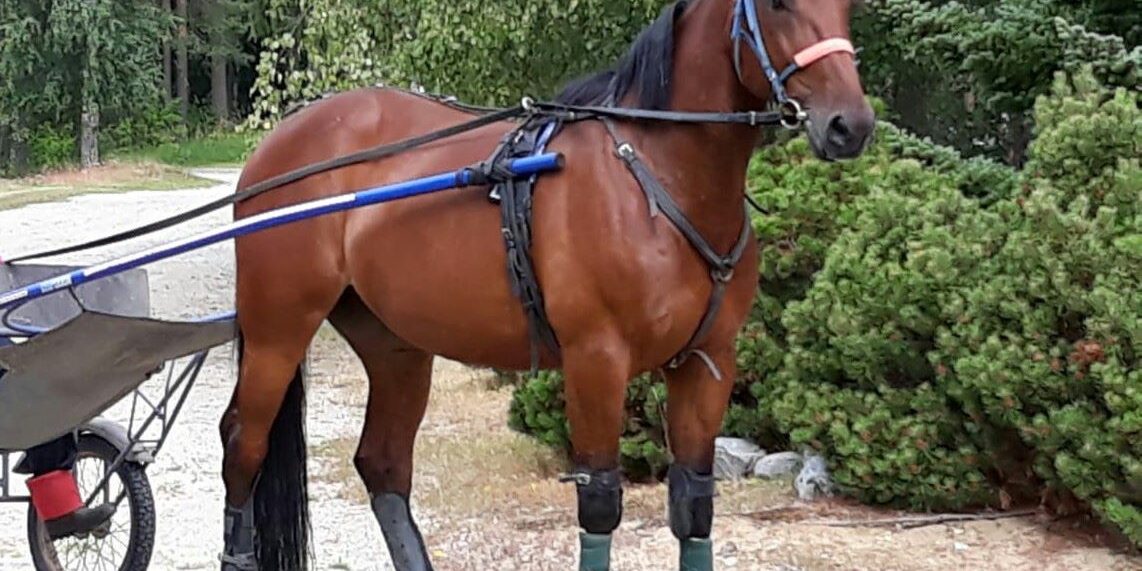Dear Sir / Hello Jim (whatever suits you best)
I have a Standardbred gelding, 8 years old, and two Shetland pony mares, 12 and 5 years old. They are either in training or harness racing. We have quite an active harness racing community for ponies here in Finland.
The performance of the elder pony has been varying on the races lately, sometimes her own level, sometimes slow or disqualified without any logic. Finally after the last race her right shoulder got very stiff and muscles on the left loin hot, sore, swollen and tense. I called our vet, and we got an appointment at her clinic 15th of October. We are planning to check her teeth/ mouth, blood values, x-raying her stomach for sand plus of course examining her legs and treating them if necessary.
While waiting to see my Euros fly by I tried cooling arnica gel (works wonders with chronically stiff owner), stretching and massage. The shoulder got much better, but the loin only slightly. I was suspecting harness or the chariot being slanted and tried lungeing her lightly in canter instead of driving, but her movement went only worse and she refused any further co-operation. I decided I was doing something terribly wrong, and got to my computer doing online search. I watched lots of videos, some of them making me sad and angry for the horses “treated”, some of them showing nothing new, until I stumbled upon your videos about hind release points and using bladder meridian to release pain. Horses looked so content, happy even, while you were working with them, and even more, they seemed to be happy with you, so I tried your method the same day.
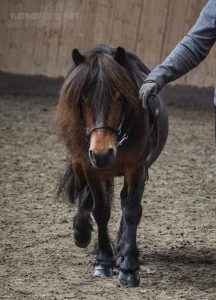 I tried the elder pony mare first, and that was really amazing. She was a real schoolbook example for both Bladder Meridian and Hind Release points, straightforward search-response-stay-release. Only point she reacted strongly was her left inner thigh. She bolted and nearly kicked (not me though, she’s not that kind) when I touched the point inside her left knee. I stepped back and tried again, this time barely touching her, and she accepted my touch. After some fidgeting she suddenly dropped her left pelvis, and the whole left hindquarter with a huge sigh and yawn. Then she allowed me to gently palpate the inner thigh, resting her leg relaxed on the tip of her hoof. It turned out that her muscles on the left knee and thigh are smaller, and more tense than on the right, so I guess I finally got near the root cause. Now it’s up to the vet to go on from there.
I tried the elder pony mare first, and that was really amazing. She was a real schoolbook example for both Bladder Meridian and Hind Release points, straightforward search-response-stay-release. Only point she reacted strongly was her left inner thigh. She bolted and nearly kicked (not me though, she’s not that kind) when I touched the point inside her left knee. I stepped back and tried again, this time barely touching her, and she accepted my touch. After some fidgeting she suddenly dropped her left pelvis, and the whole left hindquarter with a huge sigh and yawn. Then she allowed me to gently palpate the inner thigh, resting her leg relaxed on the tip of her hoof. It turned out that her muscles on the left knee and thigh are smaller, and more tense than on the right, so I guess I finally got near the root cause. Now it’s up to the vet to go on from there.
I have now worked with her Bladder Meridian for two more times, three evenings at the row. The second day when my fingers touched her right side withers, she immediately dropped her left pelvis with a huge sigh, yawning and licking. Today she relaxed her diagonal pelvis already when I started with her neck and reacted to different points only by turning her ears backwards. Not pinning, just listening to what is going on back there. I stayed on each spot as long as her ears were twitching back and forth, slowly lifting my fingers until she sighed / licked. On some spots she turned her head to me, and I gently corrected her neck straight a few times until she pressed her neck against my fingers and I realized she wanted more pressure. OK, I gave her more pressure, and she responded with ears twitching, eyes closing and finally her head going down with a sigh. I went through the Bladder Meridian on both sides, and got to that left inner thigh and knee. She was already relaxing her left hind. I noticed her skin on the left stifle being thick and hard as a plank and not moving at all over the relaxed muscles, so I started to gently move the skin doing slow little rounds with the tip of my fingers. She listened to it, her ears and eyes slightly alarmed, then decided it’s OK. I went with my instincts and placed my both palms softly on her and gently moved a larger area of her skin with slow round movements. After a while she started moving herself a little bit under my palms placing them on the better spot. (That little lady sure knows how to make the most of her servants!) Sometimes she stretched her upper lip, sometimes sighed and yawned, sometimes licked. Sometimes she looked at me with the gentlest eye. I ended up going through the whole pony that way, she was enjoying it so much. When I put on her blanket, she pressed her head gently against me and stayed like that for a few moments. I guess I did something right today to be rewarded like that.
All this is amazing, but even better is that after two sessions she was already moving better, galloping and bucking around the paddock like a young foal. Today we also tried a bit of exercise with loose jumping a low gymnastic line, and she was doing it with her ears forward, clearly enjoying herself while using her hind legs and back like she hasn’t used for a while.
The younger pony mare is one happy-go-lucky little thing, I guess she has nothing to release, for she was just acting like it was some fun new game mom has invented (“Oh please scratch there, a little bit to the left if you don’t mind). I will try again with her in time, but currently these older guys – and the lady – are needing my attention more.
The younger gelding also reacted strongly while I was working his Bladder Meridian at his neck at the first time. Curious thing was that his coat got moist under my fingers, even when I was barely touching him. When I moved my fingers to a new spot, it was dry, but got moist after a moment. Even though it is unusually warm for this time of year in Finland, there was still only +12 degrees Celsius (53F) and horses standing still don’t sweat at that temperature. Today I worked the bladder meridian at his neck also while he was already in his stall for the night. Left side he was happy to listen to and release, right side he moved away and evaded my touch. I went peacefully after him and gently slid my fingertips along the meridian, barely touching him. Over and over again, with slow continuous movement with both hands following each other. After a while I got his attention, then he started talking to me again. He turned to me, offering different spots of his neck, sometimes listening to my touch, sighing and releasing, sometimes pushing me gently with his muzzle or massaging me with his upper lip.
He asked me to switch sides, which I gladly did, and then switch back to the right where I was asked to use more pressure by him pressing his neck to my fingers. I stayed on the spot and used the pressure he himself used, less if he moved slightly away, more, if he moved towards my fingers. It was wonderful. When I was about to leave, he followed me and asked for more.
I had the most rewarding and emotional horse-human-interaction experience tonight, and I am deeply grateful to you for that. Also my horses seemed happy with their human, and like me more, which I am even more grateful for. We’ve got along quite nicely before, but in the last few days my human staff index has rocketed, at least for now.
I have always been accepted by them, even liked, I think, but tonight I was accepted not only as their human, but as their equal. As a horse communicating with other horses. I can’t explain it any other way. It goes beyond any words.
My first horse, Finnish horse gelding, a true old-fashioned light work horse, taught me to listen to horses. If I was a stubborn or inattentive teenager, he used tough love to make his point. When I was treating him like a good horsewoman should, he was the sweetest, kindest equine which has ever walked on Earth. I used to think I was training him, but later I realized it was the other way around. He was also a very attentive and loyal horse. Even when we met a bear in the forest, he turned around and waited just enough time to keep me on his back and regain my balance and then bolted forward and brought us both safely home. After a couple of years he got me educated to his liking, so he decided to follow me without halter or lead. My second horse, a Furioso-TB gelding riding horse, put me to learn more horsemanship, with a steep learning curve, and when I did, he was happy to follow me anywhere, with or without bridle or halter. If my human capabilities failed us, his braveness and quick thinking saved the day. He did unbelievable catches when trying to keep me in the saddle.
Now, with just a couple of videos about The Masterson Method, you have expanded my understanding, blown my mind and given me a way to be a better human to my current and future horses. This world can be a hard place for horses serving the humans. Even if we don’t count sheer cruelty, which we are not freed from even today, ignorance and poor understanding for even the most well-meaning horse-owner’s beloved horse, suffer pain or discomfort. By educating us you are making this world a much better place, for our horses and also for us.
Thank You.
With kind regards,
Kati Pukki, Leppävirta, Finland
Jim’s response:
Dear Kati,
You’re welcome. I appreciate you sharing this with us. We get a lot of emails from people who get profound changes in their horses using this light touch but it’s nice to have a little bit of the horse’s story to go along with the them. I’m happy to see you’re paying attention to what’s going on with your horses. Harness racing can be a rigorous sport. It looks to me like you have a good feel for this bodywork and are doing a good job with it.
Regarding your elder mare, I’ve come across this a lot where the performance and/or comfort of the horse deteriorates – sometimes even to the point of lameness – but no cause can be found in the feet and legs. When this type of lameness shows up and can’t be diagnosed, there’s always the probability that it’s up in the body somewhere. When it’s in the hind end, I refer to it as… don’t laugh… “mystery hind-end lameness”.
The main gist of it is to focus on releasing tension in three hind end structures that work together: sacrum, psoas and deeper groin muscles. While you can’t physically access some of the deeper muscles involved, you can use light touch and feedback from the horse to find out where and how to get the horse’s body to release tension in these deeper structures. The lighter you go with these techniques, the deeper the horse feels and releases the tension. Don’t ask me why. The horse isn’t telling us, and probably doesn’t really care, “why”. She is telling us where, and when it’s working. Go figure!
Another interesting thing that comes up when we’re paying attention to the horse is that the horse will demonstrate interconnections in the body that it is feeling during the bodywork. One is the connection between the neck/shoulder/withers junction and the hind end, ventrally in the groin area.
Often while working in the lower neck area you’ll see the horse stomp a hind foot, possibly because he’s feeling something deeper in the groin area. The stifle and the groin go together, as do stifle soreness and soreness in the flank or loin. Your mare is demonstrating these connections. (Good eye!)
The sweating that you, I mean your gelding, experienced sometimes occurs and seems to be associated with the process of releasing tension. Other temporary changes such as hair patterns and occasionally skin breaking out in hives can take place. Again; don’t know the science behind this, just that it happens.
In any case I wanted to thank you for sharing this, and to let you know you’re on the right track, and to keep up the good work. And keep us informed!
Sincerely,
Jim
Learn more about The Masterson Method® by ordering a copy of the Beyond Horse Massage Book.
Get hands-on training at a Beyond Horse Massage Weekend Seminar near you.
To read more about Mystery Lameness, here are two articles written by Jim Masterson in Performance Horse Digest.
